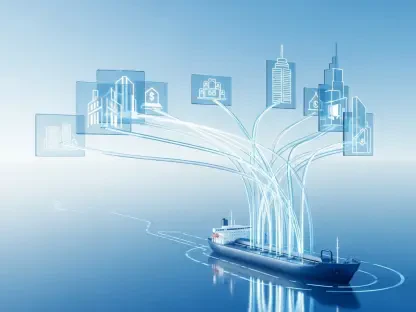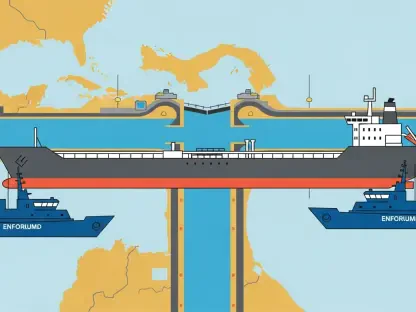The industrial waste management sector in Europe is experiencing an extraordinary surge, with market projections estimating a staggering value of $70.84 billion by 2033, driven by a steady compound annual growth rate (CAGR) of 4.63% starting from this year. This remarkable growth highlights the region’s deep commitment to environmental sustainability amid growing challenges faced by industries like manufacturing, energy, and construction. As waste volumes continue to rise, the demand for innovative and efficient management solutions has become a pressing priority. Europe stands at the forefront of this transformation, propelled by stringent regulations, cutting-edge technological advancements, and a collective vision for a greener future. This article explores the critical factors fueling this dynamic market, shedding light on the policies, innovations, and regional nuances that are shaping the path forward.
Beyond the numbers lies a story of adaptation and responsibility. Industries across the continent are grappling with the dual challenge of maintaining productivity while minimizing their environmental footprint. The European Union’s (EU) rigorous policies have set a high standard, encouraging a shift away from traditional disposal methods toward recycling and resource recovery. Meanwhile, societal expectations are adding pressure, as public awareness of environmental issues drives demand for corporate accountability. Despite obstacles such as high costs and regulatory inconsistencies, the market’s trajectory remains optimistic, supported by substantial investments and a shared commitment to sustainability.
Regulatory Framework and Policy Impact
Driving Sustainability Through EU Directives
The EU’s regulatory framework serves as the backbone of the industrial waste management market’s expansion, providing a structured approach to tackling environmental challenges. Key policies like the Waste Framework Directive lay out a clear hierarchy for waste handling, prioritizing prevention, reuse, recycling, recovery, and disposal in that order. This structured guidance compels industries to adopt sustainable practices, transforming waste management from a mere obligation into a strategic opportunity. The Circular Economy Action Plan complements these efforts by advocating for a closed-loop system where resources are reused to the greatest extent possible. Such policies not only ensure compliance but also foster a competitive edge for companies that innovate in line with these sustainability goals, positioning Europe as a global benchmark.
Another dimension of these directives is their role in reshaping corporate mindsets across diverse sectors. By embedding sustainability into legal requirements, the EU has created an environment where businesses must integrate waste reduction into their core operations. This shift is evident in how industries are reevaluating supply chains to minimize waste generation at the source. Furthermore, the emphasis on recycling targets pushes firms to invest in advanced sorting and processing technologies to meet stringent standards. While compliance can be resource-intensive, the long-term benefits of reduced environmental impact and enhanced public perception are driving widespread adoption of these practices across the continent.
Financial Commitments to Infrastructure
Substantial financial backing from the EU underscores the region’s dedication to modernizing waste management systems, ensuring they align with ambitious environmental objectives. A notable example is the €10 billion plan for waste management infrastructure announced in October 2023, aimed at bolstering recycling capabilities and expanding waste-to-energy (WTE) capacities across member states. This investment addresses critical gaps, particularly in regions where outdated systems hinder progress, and reinforces Europe’s leadership in sustainable waste practices. By channeling funds into infrastructure development, the EU is laying the groundwork for a more resilient and efficient market that can handle the complexities of industrial waste.
Equally important is the ripple effect of such investments on innovation and collaboration within the sector. The influx of funding encourages public-private partnerships, enabling shared expertise and resources to tackle large-scale projects. This financial support also facilitates the adoption of advanced technologies that smaller entities might otherwise find cost-prohibitive. As a result, even less developed areas of Europe are gaining access to state-of-the-art facilities, helping to standardize waste management practices across diverse regions. This strategic allocation of resources not only enhances operational efficiency but also ensures that environmental benefits are distributed more equitably, fostering a unified approach to sustainability.
Technological Innovations in Waste Management
Waste-to-Energy as a Game Changer
Technological progress is redefining the landscape of industrial waste management in Europe, with waste-to-energy (WTE) systems emerging as a transformative solution to longstanding challenges. By converting industrial waste into usable energy, these systems address two critical needs: reducing the burden on landfills and contributing to renewable energy targets. This dual advantage positions WTE as a cornerstone of Europe’s waste strategy, offering a sustainable alternative to traditional disposal methods. With ongoing investments in WTE infrastructure, the technology is becoming increasingly accessible, enabling industries to integrate energy recovery into their waste management processes while aligning with broader environmental goals.
The impact of WTE extends beyond immediate waste reduction, influencing long-term energy policies across the continent. As industries adopt these systems, they contribute to a growing supply of renewable energy, which helps mitigate reliance on fossil fuels. This shift is particularly significant in energy-intensive sectors like manufacturing, where waste generation is high, and energy demands are substantial. Governments and industry stakeholders are recognizing the potential of WTE to create a symbiotic relationship between waste management and energy production, driving further research and development to enhance efficiency. The result is a forward-thinking approach that not only tackles waste accumulation but also supports Europe’s transition to a low-carbon economy.
Private Sector Leadership and Innovation
Industry giants are playing a pivotal role in advancing waste management through significant investments and innovative practices, setting new standards for the sector. A prime example is the €2 billion expansion by a leading company in Germany, focused on enhancing recycling technologies to maximize resource recovery. Such initiatives highlight the private sector’s alignment with public sustainability goals, demonstrating a commitment to reducing environmental impact through cutting-edge solutions. These investments are not just financial but also strategic, as they position companies as leaders in a market increasingly driven by eco-conscious demands and regulatory expectations.
In addition to large-scale investments, the integration of digital tools is revolutionizing operational efficiency in waste management. Advanced software for waste tracking and data analytics enables real-time monitoring of waste streams, ensuring transparency and optimizing resource allocation. This technological leap is particularly beneficial for managing complex waste classifications, such as distinguishing between hazardous and non-hazardous materials, which require specialized handling. By leveraging digital solutions, companies can streamline compliance with diverse regulations while minimizing operational errors. This trend of digital adoption, combined with private sector innovation, is creating a more agile and responsive market, capable of addressing both current and emerging waste management challenges with precision.
Regional Dynamics and Market Challenges
Western vs. Eastern Europe: A Tale of Two Markets
The industrial waste management market in Europe reveals stark contrasts between regions, with Western Europe maintaining a dominant position due to its well-established infrastructure and stringent regulatory enforcement. Countries in this area benefit from advanced facilities and a culture of environmental accountability, which have made them hubs for innovation and investment in sustainable practices. This leadership is reflected in higher recycling rates and the widespread adoption of technologies like WTE, setting a high standard for waste handling. The robust systems in place allow Western Europe to manage large volumes of industrial waste efficiently, reinforcing its role as a model for others to emulate.
Meanwhile, Eastern Europe is emerging as a significant growth area, fueled by rapid industrialization and urbanization that have heightened the need for modern waste management solutions. Although historically lagging in infrastructure, the region is witnessing increased investments and public-private partnerships aimed at closing the gap with its western counterparts. However, disparities in funding and regulatory consistency continue to pose challenges, often slowing the pace of progress. Efforts to harmonize standards through cross-border collaboration are critical to ensuring that growth in Eastern Europe translates into sustainable outcomes, preventing the region from becoming overwhelmed by the environmental consequences of industrial expansion.
Navigating Operational and Regulatory Hurdles
Despite the positive momentum in the market, several obstacles threaten to impede seamless growth across Europe, with high operational costs being a primary concern. Implementing advanced waste processing technologies, such as WTE or sophisticated recycling systems, often requires significant capital investment, which can be prohibitive for smaller players in the industry. These financial barriers limit the ability of some companies to keep pace with market leaders, potentially widening the gap between large and small operators. Addressing this issue will require innovative financing models and targeted support to ensure that all market participants can adopt sustainable practices without compromising their economic viability.
Another pressing challenge lies in the varying regulatory landscapes across EU member states, which create compliance complexities for businesses operating in multiple regions. Differences in national laws and waste classification systems—particularly for distinguishing hazardous from non-hazardous waste—can lead to inefficiencies and increased administrative burdens. This inconsistency often hampers the ability to implement uniform waste management strategies, underscoring the need for greater harmonization. Digital tools for tracking and reporting offer a potential solution by enhancing transparency, while cross-border cooperation among policymakers could help align regulations, creating a more cohesive framework that supports market growth and environmental goals.
Future Outlook and Strategic Considerations
Building on Collaborative Successes
Reflecting on the strides made in Europe’s industrial waste management sector, it is evident that collaboration between public and private entities has played a crucial role in achieving milestones. The synergy of EU policies, such as the Waste Framework Directive, with corporate initiatives like major investments in recycling technologies, demonstrates how shared goals can drive transformative change. The €10 billion infrastructure plan, alongside private sector commitments, shows a unified effort to modernize systems and reduce landfill dependency. These partnerships set a precedent for tackling complex environmental challenges through collective action, ensuring that resources and expertise are leveraged effectively.
Charting the Path Ahead with Innovation
Looking forward, the focus should shift toward scaling innovative solutions to address persistent challenges and sustain growth in the market. Prioritizing the expansion of digital tools for waste tracking can enhance operational efficiency, providing real-time insights to optimize processes. Additionally, fostering cross-border initiatives to standardize regulations will be essential in creating a unified market environment, reducing compliance burdens for businesses. Encouraging smaller players through accessible funding mechanisms will ensure broader participation in sustainable practices. As Europe continues to lead globally, these strategic steps will solidify its position, balancing industrial progress with environmental stewardship for a resilient future.









